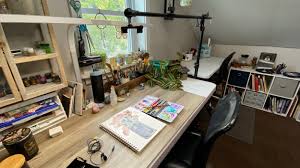The Benefits of Online Art Classes for Teachers
Art education plays a crucial role in fostering creativity, critical thinking, and self-expression among students. As educators, teachers can enhance their teaching skills and bring new perspectives to their classrooms by participating in online art classes specifically designed for them.
Convenience and Flexibility
One of the key advantages of online art classes for teachers is the convenience and flexibility they offer. Teachers can access course materials, lectures, and assignments at their own pace and schedule, allowing them to balance professional development with their teaching responsibilities.
Professional Growth
Participating in online art classes can help teachers enhance their artistic skills, learn new techniques, and explore different mediums. By expanding their knowledge of art history, theory, and practice, teachers can bring fresh ideas and approaches to their classrooms, enriching the learning experience for their students.
Networking Opportunities
Online art classes also provide teachers with valuable networking opportunities. Through virtual discussions, group projects, and collaborative activities, teachers can connect with fellow educators from around the world, share resources and best practices, and build a supportive community of like-minded professionals.
Integration into Curriculum
By taking online art classes tailored for teachers, educators can learn how to integrate art into various subjects across the curriculum. From incorporating visual arts into science lessons to using creative projects to teach history or literature, teachers can discover innovative ways to engage students and make learning more interactive and enjoyable.
Continuing Education Credits
Many online art classes for teachers offer continuing education credits or professional development hours that can contribute to career advancement and certification requirements. By completing these courses, teachers not only enhance their skills but also demonstrate a commitment to lifelong learning and professional growth.
In conclusion, online art classes provide valuable opportunities for teachers to expand their artistic abilities, gain new insights into teaching practices, and connect with a diverse community of educators. By investing in professional development through online art courses, teachers can inspire creativity in themselves and their students while making a lasting impact on the future of arts education.
Top FAQs for Art Teachers: Online Teaching, Course Selection, and Starting Your Journey
- Can I teach art online without a degree?
- Are online art classes worth it?
- Which course is best for an art teacher?
- How to start teaching art online?
Can I teach art online without a degree?
For those wondering if they can teach art online without a degree, the answer is yes, it is possible. While having a formal degree in art education or a related field can provide valuable knowledge and credentials, many online platforms and educational institutions offer opportunities for individuals with artistic talent, experience, and a passion for teaching to share their skills with students. Teaching art online without a degree may require demonstrating proficiency in your chosen artistic medium, developing engaging lesson plans, and building a strong portfolio to showcase your expertise. Continuous learning, professional development, and networking within the art education community can also help aspiring online art instructors succeed in sharing their creativity and inspiring others through virtual teaching platforms.
Are online art classes worth it?
The question of whether online art classes are worth it is a common one among teachers seeking professional development opportunities. The value of online art classes lies in their convenience, flexibility, and ability to enhance teaching skills and creativity. By participating in well-designed online art courses, teachers can expand their knowledge, learn new techniques, and connect with a global community of educators. The opportunity to earn continuing education credits and integrate art into their curriculum further adds to the benefits of online art classes for teachers. Ultimately, the worth of online art classes depends on the individual teacher’s goals, commitment to learning, and willingness to explore new avenues for personal and professional growth.
Which course is best for an art teacher?
When considering which course is best for an art teacher, it is important to assess individual interests, goals, and areas of professional development. Art teachers may benefit from courses that align with their specific teaching needs, such as courses focusing on a particular artistic medium, art history, curriculum development, or integrating art across disciplines. Additionally, courses that offer practical skills, innovative teaching methods, and opportunities for networking with other educators can enhance an art teacher’s classroom practice and overall teaching effectiveness. Ultimately, the best course for an art teacher is one that not only enhances their artistic skills but also empowers them to inspire creativity and critical thinking in their students while staying current with trends in art education.
How to start teaching art online?
Starting to teach art online can be a rewarding and transformative experience for educators looking to expand their teaching practice. To begin teaching art online, teachers can start by familiarizing themselves with various online platforms and tools that facilitate virtual art instruction. Creating a structured curriculum that aligns with learning objectives and student needs is essential, along with incorporating interactive elements such as video demonstrations, virtual galleries, and collaborative projects to engage students in the online learning environment. Additionally, establishing clear communication channels, providing constructive feedback, and adapting teaching methods to suit the online format are key factors in successfully transitioning to teaching art online. By embracing creativity, flexibility, and technology, teachers can embark on a fulfilling journey of sharing their passion for art with students in the digital realm.

